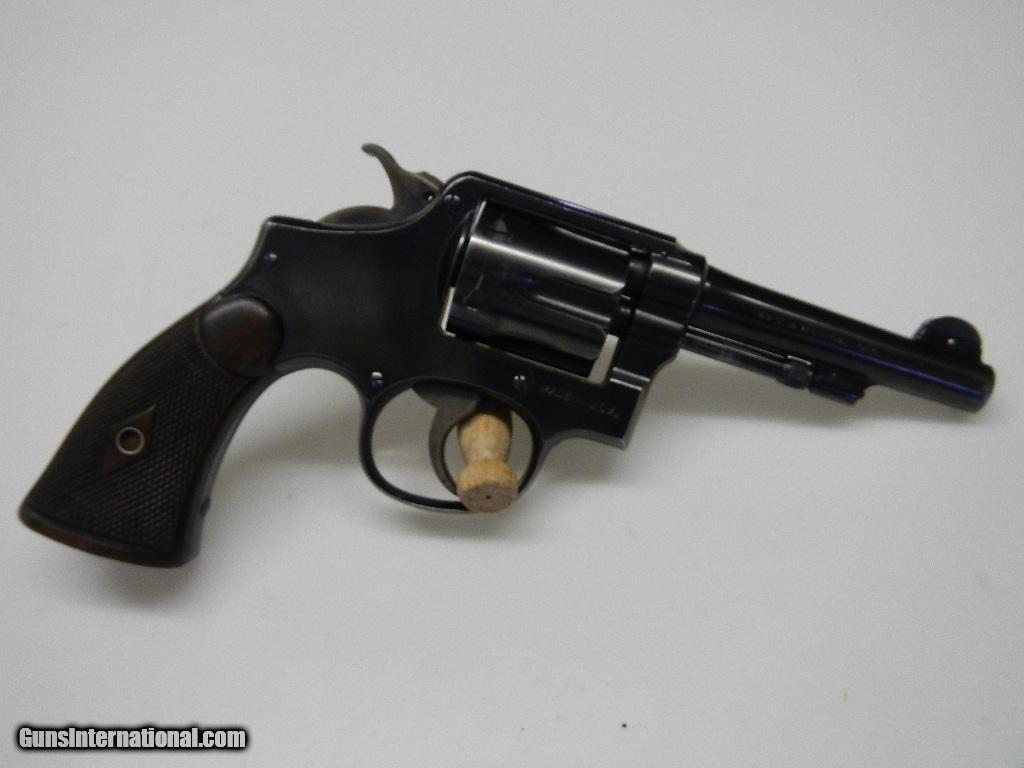- Smith & Wesson makes.38 Special revolvers. The.38 Special CTG revolver is a six-shooter with a 6-inch barrel. Identifying the weapon is a matter of locating the identifying etchings with the serial number along the gun metal on the barrel. In addition, the Smith & Wesson logo gives away the maker of the firearm.
- 38 Special Smith And Wesson Serial NumbersHave a read of these links www.northeastshooters.com Forum Hardware Firearms. Jun 5, 2009 - 10 posts - 8 authors Many people have questions about how to identify a S&W revolver and when was it made. Sometimes the serial number is here, especially in later mo.
The Victory Model Smith and Wesson .38 Caliber Revolver
Smith and Wesson Serial Number Date of Manufacture J Frame Revolver Lookup For models 36, 37, 38, 49, 50 and pre model number versions. 1950 = start at 1 1952 = 7369 - 21342. Since 1852 we’ve been an industry leading manufacturer of pistols, revolvers, rifles, and shooting accessories. We continue to bring innovative firearms to market that meet the needs of every shooter and deliver on exceptional quality with a brand you’ve learned to trust. I have a mod 15-3 smith and wesson K-38 its a 6 shot double action has a 2' pinned Barrel and diamond grips i assume was made between 1964-1982 serial on grip is 10K4802 theres another number on cylinder arm 76043 under that is D14. Anyone tell me what these numbers say.
Smith And Wesson Serial Number Search Site
The revolvers of the U.S. armed forces have always been under appreciated by collectors, the good news is that makes them relatively inexpensive to acquire, but this is changing. At a recent trip to the 2003 Louisville gun show I noticed prices on Victory revolvers had increased noticeably. That being said you might want to consider adding a few Victory models to your USGI collection.
While the information I provide below can be helpful please see the list on the bottom of this page for reference material you should have if you are going to collect these historical pieces . The Victory model revolvers participated in various roles from guard duty to riding in a shoulder holster with fighter and bomber pilots. I have talked to many ex-military personnel that carried them as late as the 1980s, as you can see these pistols played a significant part of our history. To this day the Victory model is a very enjoyable shooting collectible, mainly due to its inexpensive cost, light recoil, and good accuracy.
Enjoy and happy collecting, Ty
The Victory model was so named for the 'V' prefix which was placed before the serial number and represented 'Victory' against the Axis powers in World War II.
Serial numbers for the .38 special Victory model began at about V1 in early 1942 and ran until VS811119 with a date of late August of 1945 (end of production). V1 to approximately V39,999 were predominately .38 S&W Caliber (I have observed revolvers in the 1-40000 range in .38 special caliber). Serial numbers are located on Inside right grip, frame butt, Cylinder, extractor star, and bottom of barrel. Crane and crane recess are also serial numbered to each other, but this is a different number then the revolvers serial number as is correct for Victory model revolvers.
The Victory Revolver was produced during World War II, it is a variation of the Military & Police Model of 1905, fourth change and had the following characteristics between 1942 and 1945:
Barrel: 2, 4, 5, or 6 inch. (4 inch common in .38 special, 5 inch common in 38/200 or .38 S&W)
Sights: Fixed
Finish: Early sandblast blue, sandblast mid-night black (appears grayish black). And finally a parkerized finish. Hammer and Trigger are case hardened.
Grips: Checkered walnut with medallion until early 1942, post February of 1942 they are smooth American Walnut with out medallions.
Ordnance acceptance marks:
The acceptance mark varies with the particulars of the order placed. With U.S. Navy orders you will find no acceptance marks on the original two contracts they placed. On later Navy revolvers, ordered through the Army they will be found with the more typical Army G.H.D. acceptance mark. Below you will find some of the common stamps with links to examples.
.jpg)
W.B. - The acceptance mark of Ordnance officer Waldemar Bromberg is located on the butt (to about serial number V145000). Just to the right of the acceptance mark (W.B.) is usually found an ordnance bomb and proof mark. The 'P' proof mark indicates this revolver has passed military proof testing. EXAMPLE – Click Here
G.H.D – From approximately 1942 to about May 1943 the acceptance mark of Ordnance officer Guy H. Drewry is found on the butt. From approximately V300000 to end of production G.H.D is found on the left top strap; EXAMPLE – Click Here
Smith And Wesson 38 Chiefs Special Serial Number Lookup
Property marks:
The most common property marks found on the Victory model are the UNITED STATES PROPERTY, US PROPERTY, and the US NAVY markings.
UNITED STATES PROPERTY – Found on left top strap to approximately V300000 and on the M&Ps pre Victory. Applied at the S&W factory. Example - Click Here
U.S. PROPERTY – The property mark was shortened to 'U.S. PROPERTY' at about serial number V300000. At this time the G.H.D acceptance mark was moved from the butt to the left top strap with the property mark. Applied at the S&W factory. EXAMPLE – Click Here
U.S. NAVY – Found on the revolvers left top strap as per the two Navy contracts. The Navy also applied a Property mark on the left side plate on some revolvers; these were filled in with red paint. This is not an S&W applied marking. EXAMPLE – Click Here and Here for the Navy applied mark.
Victory models have also been produced with out property marks, these revolvers were probably delivered by the U.S. Defense Supply Corporation (DSC) to defense contractors and public agencies that required them for guarding war sensitive materials.
Other common markings:
S - Revolvers that have the 'S' marking on the right side plate as well as before the serial number on the butt have the improved hammer block installed. If the 'S' in the serial number on the butt appears to be machine applied this would indicate it was produced with improved hammer block, and that it was not added later or it would have been hand stamped. The improved hammer block was put into production after an accidental discharge killed a sailor during World War II. This improved hammer block is still utilized in today's commercial Smith and Wesson revolvers. EXAMPLE – Click Here
P – Proof marking. This can very depending on the contract. Navy marked pistols usually have none. But C.W. Pates books indicate that some delivered under an Army contract could be found with a P mark. Post the V400,000 serial number range they are located on the underside of the barrel, back of the cylinder and left side plate. The later appear to be Army Supply Program contract revolvers. EXAMPLE – Click Here


Serial Numbers:
Serial numbers are located on the inside right grip, frame butt, Cylinder, extractor star, and bottom of grip. Serial numbers should be matching on all revolvers. Crane and Crane recess are also serial numbered to each other, but this is a different number then the revolvers serial number and is correct for Victory model revolvers.
Grip/StockEXAMPLE – Click Here
Barrel EXAMPLE – Click Here
Cylinder EXAMPLE – Click Here
Extractor Start EXAMPLE – Click Here
Butt EXAMPLE – Click Here
Production:
38/200 British Service Revolver (S&W Caliber) - There were over 571,629 of these models produced between October 1941 and May 1945 for the British Common wealth countries. These countries include the Union of South Africa (21,347), Canada (45,328), and Australia (8,000). The remaining 384,100 shipped between 1941 and the end of World War II were supplied by the U.S. Army Ordnance through the lend lease program to Britain for distribution.
Victory model 38 Special – 352,000 shipped to the Army and Navy. Some of these were shipped to a commission responsible for supplying the civilian industries. They will usually have no property marks. Uses included guarding factories, ports, and federal/local government agencies.
Note: You can find all kinds of variations, with additional war and post war markings. These include rebuild markings, country ownership markings, unit markings, and much more. For a complete listing see the books referenced below.
Recommended reading:
US Handguns of WW II - The Secondary Pistols and Revolvers by Charles W. Pate
Americas Right Arm - The S&W Military and Police Revolver by John Henwood
Smith and Wesson 1857 - 1945 by Robert J. Neal and Roy G. Jinks

